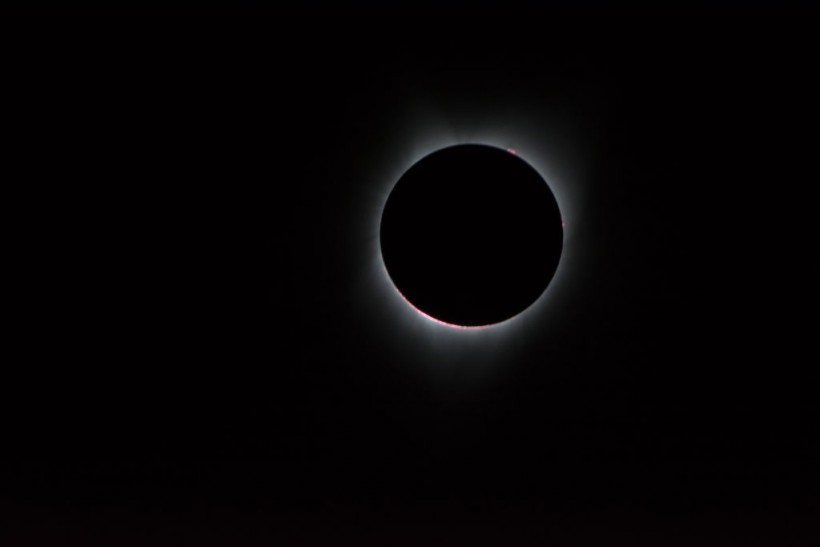A total solar eclipse, unfolding on April 8, 2024, will cast a shadow over 10 major cities in North America, offering about four minutes of captivating darkness. A unique cosmic display is anticipated as temperatures drop by around 10 degrees Fahrenheit, prompting a hush among birds and insects.
Witness plants adjusting their metabolic pace and nocturnal creatures, such as owls and bats, stirring into motion, as this extraordinary celestial event promises an enthralling experience for those within its trajectory.

In this NASA handout, the Sun's corona, only visible during the total eclipse, is shown as a crown of white flares from the surface during a total solar eclipse on Monday, August 21, 2017 from onboard a NASA Gulfstream III aircraft flying 25,000 feet above the Oregon coast.
10 Major Cities in Northern America in Path for the Total Solar Eclipse
Between 40 and 50 million people, including residents and visitors, are expected to witness the total solar eclipse on April 8, with around 10 million in the 10 largest cities along the path of totality. Here are those cities:
- Montreal, Quebec, Canada: Montreal is on the northern edge of totality. The southern half of Île de Montréal will experience the longest totality, lasting about 2 minutes near the St. Lawrence River. Cloud cover on April 8 has been around 69%.
- San Antonio, Texas, U.S.: Split in two by the edge of totality, San Antonio's center lies outside the path. Its northern and western suburbs will experience totality. Cloud cover on April 8 has been around 55%.
- Dallas-Fort Worth Metroplex, Texas, U.S.: With over 8 million people, the metroplex is expecting 1.5 million visitors. Events include the Frontiers of Flight Museum and the Dallas Arboretum. Cloud cover in Dallas is around 60%, and Fort Worth is around 49%.
- Austin, Texas, U.S.: Central Austin will have a relatively long totality. Avoid southeastern suburbs and Austin-Bergstrom International Airport. Cloud cover in Austin on April 8 has been around 59%.
- Indianapolis, Indiana, U.S.: Indianapolis is the only Midwest city on the path. Plans for the 2024 Solar Eclipse Weekend include events at major attractions. Cloud cover on April 8 has been around 60%.
- Cleveland, Ohio, U.S.: Cleveland will experience nearly four minutes of darkness during a total solar eclipse, a rare event not expected to recur until 2444.
- Victoria de Durango, Durango, Mexico: The capital of Durango, with a dry climate, will be a base for many tour groups. It may attract eclipse-chasers from Mazatlán for clear skies. Cloud cover in Durango is around 30%.
- Hamilton, Ontario, Canada: Hamilton is busy due to its proximity to Toronto, even though it's just inside the northern limit. Cloud cover in Hamilton on April 8 has been around 61%.
- Torreón, Coahuila, Mexico: This industrial town in the country's northwest has a higher chance of clear skies, making it a historic location for the Great Mexican Eclipse. Cloud cover in Torreón is around 27%.
- Mazatlán, Sinaloa, Mexico: The beach town has been a hotspot for eclipse-chasers due to its low chance of clouds. Locals and tourists will gather on the boardwalk for the eclipse. Cloud cover in Mazatlán is around 28%.
READ ALSO: What To Expect During a Solar Eclipse? 10 Unusual Phenomena to Look Out for This Weekend
Why Is This Year's Total Solar Eclipse Special?
A solar eclipse occurs when a celestial body moves through the shadow of another, such as the moon passing between the sun and Earth. The upcoming total solar eclipse on April 8, 2024, is a rare event, offering over 31 million people in eastern North America a unique viewing opportunity.
This eclipse coincides with heightened solar activity, part of the sun's 11-year magnetic cycle, promising a dynamic display with wisps and streams exiting the sun's atmosphere. Residents and travelers alike are expected to witness this celestial dance, creating a memorable experience.
The eclipse in 2017 was impactful, but each eclipse is distinct. Scientists anticipate a visually complex sun during this event, marked by potential phenomena like a coronal mass ejection.
RELATED ARTICLE: Spectacular Solar Eclipse, Historic Launch, and Jupiter's Wonders: An Unforgettable Week in the Skies
Check out more news and information on Solar Eclipse in Science Times.



![Earth's Quasi-Moon Kamo‘oalewa Could Originate From Lunar Surface Not Asteroid Belt [Study]](https://1721181113.rsc.cdn77.org/data/thumbs/full/53275/89/56/50/40/earths-quasi-moon-kamo-oalewa-could-originate-from-lunar-surface-not-asteroid-belt-study.png)










